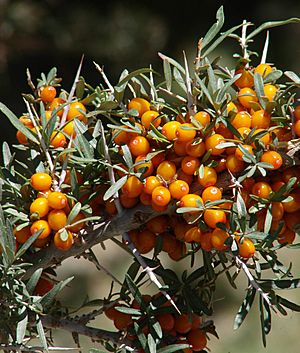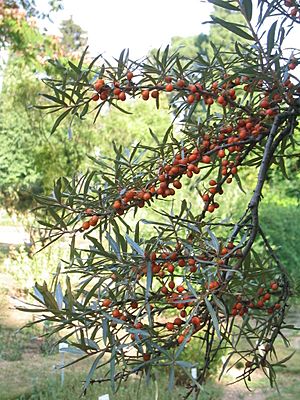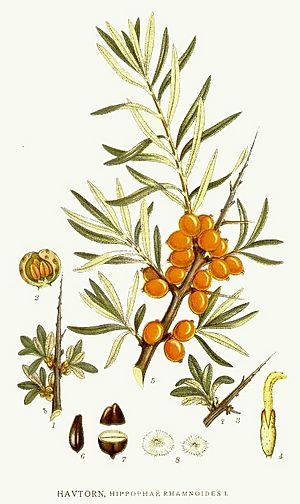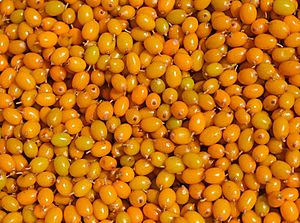Sea-buckthorn facts for kids
Quick facts for kids Sea-buckthorn |
|
|---|---|
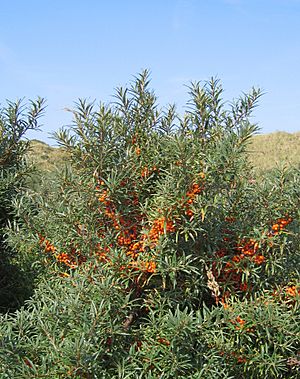 |
|
| Common sea buckthorn shrub | |
| Scientific classification | |
| Genus: |
Hippophae
|
| Species: |
rhamnoides
|
| Synonyms | |
|
|
Hippophae rhamnoides, often called sea buckthorn, is a type of flowering plant. It belongs to the Elaeagnaceae family and grows naturally in the cold parts of Europe and Asia. This plant is a spiny deciduous shrub, which means it loses its leaves in the fall. People use sea buckthorn for many things, like in food, beauty products, traditional medicine, and even to feed animals. It's also used to help the environment and for gardening.
Contents
What Does Sea Buckthorn Look Like?
Sea buckthorn is a tough shrub that can grow from 2 to 4 meters (about 7 to 13 feet) tall. It has rough, brown or black bark and a thick, grayish-green top. Its leaves are long and narrow, with a shiny, silvery-green color on top.
How Does Sea Buckthorn Grow?
Sea buckthorn plants are "dioecious." This means that male and female flowers grow on separate plants. You can only tell if a plant is male or female after it flowers for the first time, which usually happens after three years. Male flowers are small and simple, while female flowers are also small and have one part that will become a fruit.
For fruits to grow, male and female plants need to be close to each other. This is because the wind carries pollen from the male flowers to the female flowers.
The fruits are oval or round and can be light yellow to dark orange. Each tiny fruit weighs less than half a gram. They are packed with good things like vitamin C, vitamin E, and healthy fatty acids. They even have more vitamin B12 than many other fruits!
These plants have a very strong and wide root system. Their roots work with special bacteria called Frankia to help the plant get nutrients from the soil. The roots also help turn things in the soil that the plant can't use into things it can. New sea buckthorn plants can grow quickly from these roots.
Where Does Sea Buckthorn Fit In?
Sea buckthorn belongs to the plant family called Elaeagnaceae. This family is part of a larger group of plants called Rosales.
There are eight different types of Hippophae rhamnoides, called subspecies. These types are ssp. carpatica, caucasia, fluviatilis, mongolica, rhamnoides, sinensis, turkestanica, and yunnanensis. They look a bit different in size, shape, and how hairy their leaves are. They also grow in different places and are used for different things.
The name Hippophae comes from two old Greek words: hippo, meaning "horse," and phaos, meaning "to shine." This is because ancient Greeks used sea buckthorn leaves to feed horses, which made their coats shiny. The name rhamnoides means "looks like Rhamnus", which is another plant called buckthorn.
Where Can You Find Sea Buckthorn?
Sea buckthorn grows naturally in cold parts of Europe and Asia. You can find it along the coasts of countries like Finland, Poland, Germany, and the United Kingdom. In Asia, it grows in northern China, the Himalayan region (including India, Nepal, and Bhutan), Pakistan, and Afghanistan.
It can grow in many different places: on hills, in valleys, along rivers, and near the coast. It can be found alone or mixed with other shrubs and trees. Recently, sea buckthorn has also been planted in countries like Canada, the United States, and Japan.
About 3 million hectares (that's a huge area!) of sea buckthorn grow around the world. Most of this is in China, which is the biggest grower of sea buckthorn. China plants about 10,000 acres of it each year to get berries and to help the environment. Other countries like Canada, Germany, and France also grow sea buckthorn for its fruits.
What's Inside Sea Buckthorn Berries?
Sea buckthorn fruits are full of good things like sugars, fruit acids, and many vitamins (C, E, and K). They also have special plant compounds called polyphenols and carotenoids, fiber, and minerals.
The fruits contain oil in both their soft parts and their seeds. This oil is used to make other products.
The main sugars in sea buckthorn fruits are fructose and glucose. The fruits taste sour because they have a lot of malic acid.
Sea buckthorn fruits have a very high amount of vitamin C—about 400 mg in every 100 grams! This makes them one of the best plant sources of vitamin C. They also have a lot of carotenoids (like beta-carotene, which gives them their orange color) and vitamin E.
Some of the most common minerals found in sea buckthorn fruits are potassium, manganese, and copper. The fruit is also rich in plant sterols, especially β-sitosterol.
What Is Sea Buckthorn Used For?
Sea buckthorn is a very useful plant. Both its fruits and leaves can be used. The fruits are made into different products for the food, medicine, and beauty industries. The leaves can be used to feed animals, especially those that chew their cud.
Because sea buckthorn can grow in poor, salty, or eroded soils, it's also used to help fix damaged land or to create windbreaks.
Everyday Products
Almost all parts of the sea buckthorn plant have good chemicals and nutrients. The fruit is especially rich in vitamin C, even more than lemons and oranges!
In the food industry, the berries are washed and pressed. This creates juice and a leftover pulp. The pulp can be used to get oil, natural yellow or orange food coloring, or jam. The juice is then packaged as a drink.
Sea buckthorn oil can also be used to make beauty products like hand cream, shampoo, or massage oils. The leaves can be dried and ground to make tea.
Traditional Medicine
Sea buckthorn is used a lot in traditional medicine, especially in Russia and parts of Asia. People use the leaves as herbal medicine for different health issues. In traditional Austrian medicine, sea buckthorn fruits have been used as tea, juice, or syrup to help with infections.
Animal Feed
Sea buckthorn is also used to feed farm animals. The leftover pulp from processing the fruits can be given to animals like chickens.
Helping the Environment
Sea buckthorn plants are very good at handling dry weather and salty soil. This makes them useful for fixing land that has been damaged, stopping soil from washing away, creating windbreaks, or being part of special farming systems that mix trees and crops.
For example, in eastern China, sea buckthorn is planted to help reclaim salty land. It also provides a home for different birds and small animals.
Growing Sea Buckthorn
What Sea Buckthorn Needs to Grow
Sea buckthorn can grow in many types of soil, but it grows best in light, sandy soils that have lots of nutrients and are not too acidic or too alkaline (pH 6.5–7.5). Deep, well-drained sandy soil with plenty of organic matter is ideal. Very sandy soils that don't hold much water or nutrients are not good unless you add organic matter. Clay soils, which are dense and hold too much water, are also not suitable.
Even though sea buckthorn can handle dry conditions, it needs enough moisture, especially in spring when flowers and young fruits are forming. If you plant it in dry areas, you'll need to water it when it's young.
It can grow at high altitudes, up to 2000 meters (about 6,500 feet) above sea level. The plant can survive very cold temperatures (down to -43°C or -45°F) and hot ones (up to +40°C or +104°F). It starts growing when the daily temperature is around 5 to 7°C (41 to 45°F). It needs lots of sunlight and cannot grow in shady areas.
Sea buckthorn doesn't need much nitrogen fertilizer because its roots have special bacteria that can take nitrogen from the air and put it into the soil. However, it does need phosphorus for these root bacteria to work well.
Planting and Caring for Sea Buckthorn
It takes about 4 to 5 years for sea buckthorn plants grown from seeds to start producing fruit. They produce the most fruit around 7–8 years old and can keep producing for 30 years if they are pruned (trimmed) regularly. The best time to plant sea buckthorn is in the spring.
To get a good harvest, you should plant them about 1 meter (3 feet) apart in rows, with 4 meters (13 feet) between the rows. Planting on a south-east slope and having rows that run north-south helps the plants get the most sunlight.
Pruning Sea Buckthorn
Pruning helps shape the branches, encourages growth, and makes it easier to pick the fruits. Trimming the plants moderately will lead to more fruit and a longer fruiting life. You should remove branches that cross over each other and cut long branches to help new side shoots grow. Older plants that are producing fruit should be pruned to let more light reach the inside. Pruning also helps remove thorns, which makes harvesting easier. It's best to start pruning the year you plant the trees, usually in late winter.
How New Sea Buckthorn Plants Are Made
Growing sea buckthorn from seeds is not common for fruit farms. This is because you can't tell if a seedling is male or female until it's 3 to 4 years old. Since male plants are needed for pollination but don't produce fruit, farmers prefer to know the sex of the plants they are growing.
To avoid this problem, new plants are often grown from cuttings (pieces of a mature plant). This way, you know if the new plant will be male or female, and they start producing fruit 1 to 2 years earlier than plants grown from seeds. Sea buckthorn can be grown from different types of cuttings or by layering (making roots grow on a branch while it's still attached to the parent plant).
Since wind carries the pollen, it's important to have male plants close enough to female plants. Usually, about 6% to 12% of the plants in a field should be male. Female plants can be pollinated if they are within about 100 meters (330 feet) of a male plant. However, the farther a female plant is from a male plant, the less fruit it will produce.
Making Better Sea Buckthorn Plants
Because sea buckthorn plants have many different shapes and sizes, there are good chances to choose plants with the best features for a certain area. Scientists are working to create even better sea buckthorn plants. They want to improve things like how much fruit they produce, the size of the fruit, how well they survive winter, if they have fewer thorns, and how good their fruit and pollen are. They also want plants that ripen early and have long stems on the berries to make harvesting easier.
Picking the Berries
Sea buckthorn fruits ripen in the fall and can stay on the shrub until spring. A well-planted field can produce about 10 tonnes of berries per hectare (about 2.5 acres). Good plants can produce up to 7 kg (about 15 pounds) of fruit each year.
In Asia, people often pick the fruits by hand. This takes a lot of time. Harvesting the fruit is the hardest part of growing sea buckthorn. The fruits are small, have short stems, are hard to pull off, grow very close together on the branches, and the plants have thorns.
These harvesting difficulties are a big challenge for growing sea buckthorn as a money-making crop. It's hard to separate the fruit from its stem. Scientists have tried different ways to harvest mechanically, like shaking the branches or freezing them, but these methods can damage the fruit or the plant. When the fruit is frozen on the shrub, a machine can shake the trunk to release the berries. However, this method can mix leaves and wood with the berries, so they need extra cleaning.
Special Kinds of Sea Buckthorn
In the United Kingdom, two special types of sea buckthorn, 'Leikora' and 'Pollmix', have won awards for being great garden plants. 'Leikora' produces many fruits, while 'Pollmix' is used to pollinate female plants. Another type, 'Sprite', grows as a dense, low plant, which might be good for a short hedge near the sea.
Sea Buckthorn and Its Friends (and Foes)
Helpful Bacteria
Sea buckthorn plants that are 1–2 years old grow special bumps on their roots called nodules. These nodules contain tiny bacteria called Frankia. These bacteria are amazing because they can take nitrogen from the air and turn it into a form the plant can use. This helps make the soil around sea buckthorn plants richer in nitrogen. How much nitrogen the bacteria fix depends on things like the weather and if the plant has been fertilized.
Plant Problems: Diseases
Sea buckthorn plants can get sick, especially from a group of fungal diseases called "wilt disease." In China, this disease causes a lot of fruit loss and kills many plants each year. Several types of fungi can cause this sickness, including different kinds of Fusarium and Verticillium.
To control wilt disease, people remove and burn sick branches. They also avoid planting sea buckthorn in the same spot for several years. Some helpful fungi can also be used to fight the disease. Scientists have also found types of sea buckthorn that are more resistant to wilt disease.
Plant Problems: Pests
Sea buckthorn is also bothered by several insect pests. Green aphids are one of the most damaging. They feed on new shoots, which stops the plant's growth and makes the leaves turn yellow and fall off early.
Another serious pest is the sea buckthorn fruit fly. Its larvae (baby flies) eat the fruit, making it unusable. The gall tick causes bumps on the leaves, changing their shape.
Other insects like the leaf roller and the gypsy moth chew on the leaves. The scale insect sucks sap from the bark and can seriously harm the plant. The larvae of the sea buckthorn moth eat the fresh buds. Sometimes, thrips and earwigs can also affect the plants.
To control these pests, farmers sometimes use special sprays on the soil or insecticidal soap against aphids. Animals like birds, rodents, and deer can also cause damage to sea buckthorn farms.
Keeping Weeds Away
Controlling weeds is very important, especially when sea buckthorn plants are young. This is because sea buckthorn grows slower than weeds at first. Weeds should be removed before planting, and then kept under control for the first four to five years until the shrubs are tall enough to block out the weeds. Weeds are removed by hand or with machines. It's important not to dig too deep when weeding, so you don't hurt the sea buckthorn's roots.
As of 2003, there were no specific weed killers approved for use in sea buckthorn farms.
|
See also
 In Spanish: Espino amarillo para niños
In Spanish: Espino amarillo para niños


